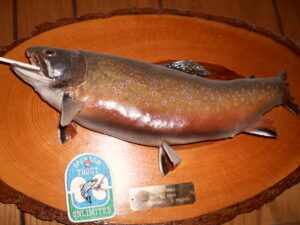Trout Season Opens

By Gary Moore
Open water trout anglers get really antsy by the end of March, often casting on the lawn and dreaming of opening day. This year that occurs on Saturday, April 9. Like so many others I will be plying the waters of local streams hoping to entice a trout to hit.
As I write this mid February, there is no way to know what opening day will bring. Often the water is high and cold and the fish lethargic. Fishing slowly and deep often works best.
Small ponds and many lakes are still ice covered but often there is a little open water at inlets and outlets that can produce some action.
There were many changes to the fishing regulations that took effect January 1 including lower limits for trout so pay close attention to the Digest.
Turkeys, Too
While we are out pursuing trout, especially along streams, is a good time to scout for turkeys. The spring turkey season opens May 1 statewide. The youth and novice hunting weekend is April 23-24.
We can take two bearded turkeys and, with the lack of snow and cold temperatures we have had this winter, there should be plenty of birds when the season opens.
Spring Snow Goose season
Vermont’s spring snow goose hunt opened March 11 and continues through April 23.
Since 2009, the U.S. Fish and Wildlife Service has annually issued a “Conservation Order” to allow the reduction of the population of migrating greater and lesser snow geese as well as Ross’ geese. The numbers of these geese have grown so high that they are destroying habitat for themselves and other species.
During spring migration, snow geese typically move through the Champlain Valley in late March and early April. They usually pass through Vermont quickly in route to their spring staging areas along the St. Lawrence River Valley. They remain there for about a month before moving on to their nesting areas in the Eastern Canadian Arctic.
“The breeding population of greater snow geese has grown from approximately 50,000 birds in the mid-1960s to 714,000 birds today,” said David Sausville, Vermont’s wildlife management program manager and waterfowl project leader. “This increase has resulted in damage to agricultural crops and marsh vegetation in staging and wintering areas from Quebec to North Carolina.”
The Vermont 2022 Spring Snow Goose Conservation Order will occur statewide. The daily bag limit is 15 snow geese, and there is no possession limit. Waterfowl hunting regulations in effect last fall will apply during the 2022 Spring Snow Goose Conservation Order with the exception that unplugged shotguns and electronic calls may be used and shooting hours will be extended until one half hour after sunset.
100 Is The Magic Number For Moose Permits
The Vermont Fish and Wildlife Department has proposed issuing 100 moose hunting permits in Vermont’s Wildlife Management Unit E in the northeastern corner of the state in order to reduce the impact of winter ticks on the moose population. The proposal was accepted by the Vermont Fish and Wildlife Board at its February 16 meeting so it is likely by the time you read this it will have completed the regulatory process.
WMU E is primarily Essex County down to Route 2 and is home to the highest moose density in the state.
The goal of the department’s 2022 moose harvest recommendation is to improve the health of moose in WMU-E by reducing the number of moose and thereby reducing the abundance and impact of winter ticks.
Moose project biologist Nick Fortin pointed out that, “Moose density in WMU E is still more than one moose per square mile, significantly higher than any other part of the state. Moose densities greater than one per square mile support high numbers of winter ticks which negatively impact moose health and survival.”
The Fish and Wildlife Department partnered with University of Vermont researchers to conduct a study of moose health and survival in WMU E. The results of this study, in which 126 moose (36 cows, 90 calves) were fitted with GPS tracking collars, clearly showed that chronic high winter tick loads have caused the health of moose in that part of the state to be very poor. Survival of adult moose remained relatively good, but birth rates were very low and less than half of the calves survived their first winter.
The department would issue 60 either-sex moose hunting permits and 40 antlerless moose permits in WMU-E for the moose seasons this October. This is expected to result in a harvest of 51 to 65 moose, or about 5 percent of the moose population in WMU-E. The same number of permits were issued in 2021 when hunters took 62 moose.
For more articles about hunting, fishing and the great outdoors, be sure to subscribe to the Northwoods Sporting Journal.
